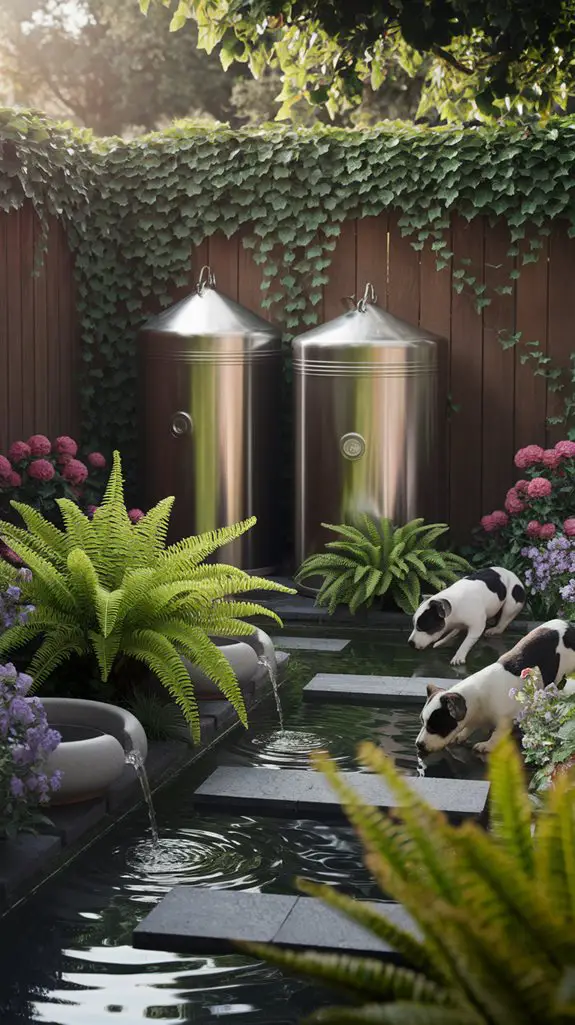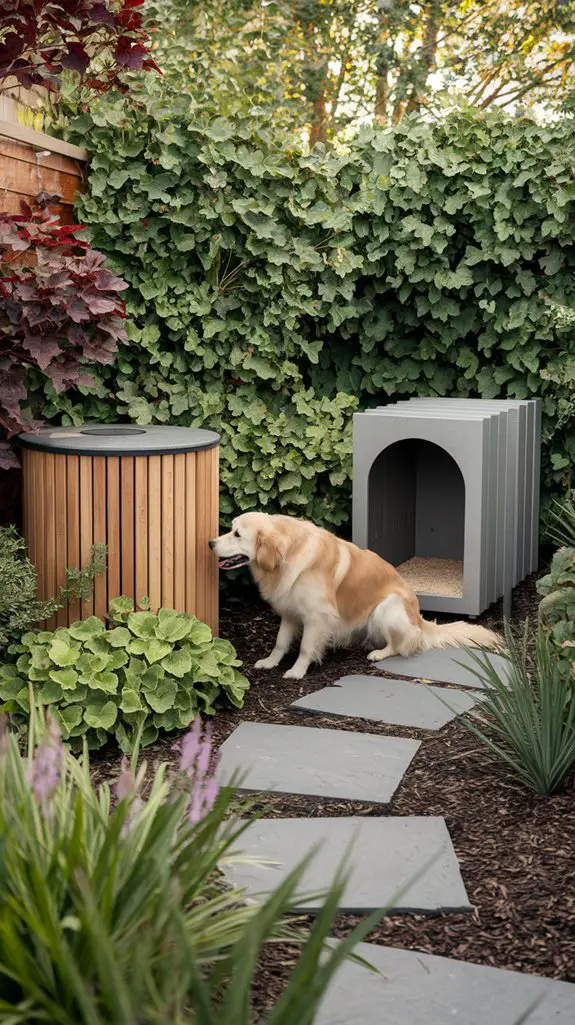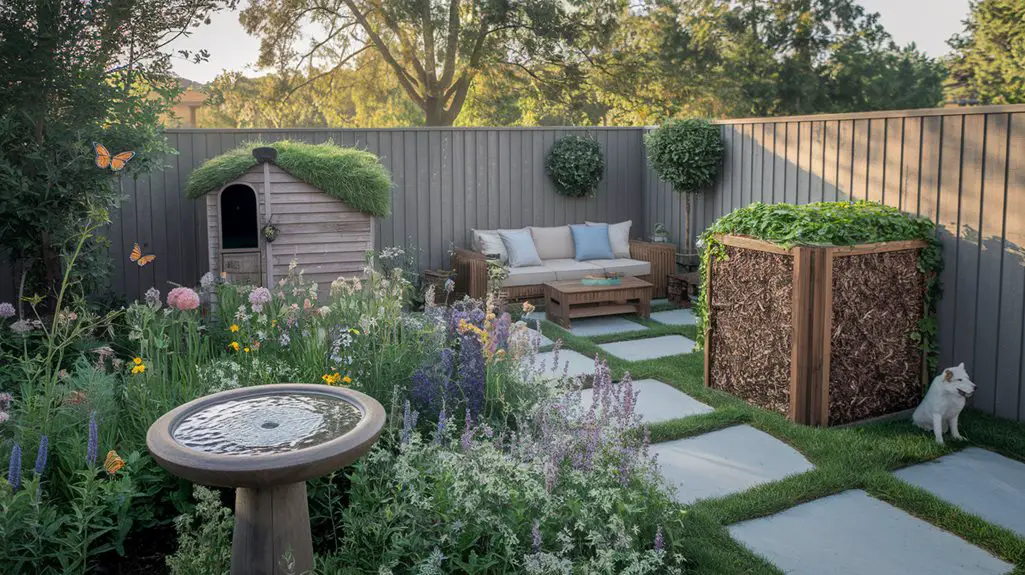Like Eden before the fall, your backyard can be both a sanctuary for your pets and a reflection of environmental stewardship. You’ll find that creating an eco-conscious outdoor space doesn’t require sacrificing your furry friends’ comfort or safety. By implementing thoughtful designs that work with nature rather than against it, you’re building a sustainable ecosystem that benefits all inhabitants. The following five approaches will transform your ordinary yard into a harmonious, pet-friendly environment that future generations—both human and animal—will thank you for.
Natural Pet-Safe Landscaping With Native Plants
While transforming your backyard into a pet-friendly haven, prioritizing native plants creates a sustainable ecosystem that benefits both local wildlife and your furry companions.
Native species require less water, fertilizer, and pesticides than exotic alternatives, reducing your environmental footprint and eliminating toxic exposure risks for pets.
Select regional grasses like buffalo grass or sedges that withstand pet traffic while providing comfortable lounging areas.
Incorporate sturdy shrubs such as ninebark or serviceberry at yard perimeters to create natural boundaries that discourage escape attempts.
For shade and cooling, position native trees like oaks or maples strategically throughout your space.
Always verify plant toxicity through veterinary resources before installation.
The ASPCA maintains extensive databases of species safe for dogs and cats, ensuring your ecological choices remain pet-compatible. Creating safe backyard spaces is vital in ensuring your pets thrive in their environment.
Rainwater Collection Systems for Pet Hydration Stations

Installing a rainwater harvesting system provides an eco-friendly solution for keeping your pets hydrated while markedly reducing your household’s water consumption. You’ll need a collection barrel, filtration system, and delivery mechanism to create a functional pet hydration station. Additionally, utilizing a rainwater harvesting system can help improve your garden’s sustainability by providing natural irrigation.
| Component | Purpose | Installation Complexity |
|---|---|---|
| Rain Barrel | Collects precipitation | Low – attaches to downspouts |
| First-flush Diverter | Removes initial contaminated runoff | Medium – requires precise fitting |
| Carbon Filter | Purifies water for safe consumption | High – needs regular maintenance |
Connect your rainwater system to an automatic pet bowl with a gravity-fed design. Install a small solar pump to circulate water, preventing stagnation and mosquito breeding. The filtered rainwater reduces chlorine exposure for your pets while supporting your sustainability goals without compromising their health.
Compostable Waste Management for Pet Owners

Managing pet waste responsibly represents one of the most significant environmental contributions pet owners can make to reduce their ecological footprint.
While traditional pet waste often ends up in landfills, you can implement a dedicated composting system specifically designed for animal waste.
Install a separate digester bin that accelerates decomposition through enzymatic action and proper aeration. These systems typically require a 2:1 carbon-to-nitrogen ratio—combine pet waste with sawdust, fallen leaves, or shredded newspaper to achieve ideal breakdown.
The resulting compost shouldn’t be used on edible gardens but works effectively for ornamental plantings.
For dog owners, consider a specialized in-ground waste digester that converts feces into liquid that safely filters through soil.
Cat waste requires more careful management due to potential parasites—use commercial pet waste composters that reach temperatures high enough to neutralize pathogens. Additionally, effective DIY traps can help manage pests attracted to pet waste in your yard.
Chemical-Free Pest Control Solutions for Pet Safety
Conventional pest control methods often contain toxic chemicals that pose serious health risks to pets who explore yards with their noses, paws, and mouths.
Instead, implement integrated pest management strategies using biological controls like nematodes to target grubs and beneficial insects to combat aphids.
Create physical barriers by installing copper tape around garden beds to deter slugs and snails.
Deploy diatomaceous earth—a microscopic algae powder that dehydrates insects—in targeted locations, avoiding areas where pets directly contact soil.
Essential oil deterrents such as neem, cedarwood, and lemongrass effectively repel ticks and fleas when properly diluted.
Companion planting with pest-repelling species like marigolds, lavender, and catnip provides dual functionality: natural pest control and sensory enrichment for your pets while maintaining your yard’s ecological balance. Additionally, incorporating organic pest control methods can enhance the effectiveness of your strategy while ensuring a safe environment for your furry friends.
Renewable Materials for Durable Pet Play Zones
Bamboo stands as one of the most versatile renewable materials for creating pet play zones that can withstand vigorous activity while reducing environmental impact.
This rapidly regenerating grass offers superior durability with minimal maintenance requirements while providing natural antimicrobial properties beneficial for outdoor pet environments.
When designing sustainable pet play areas, consider these renewable material options:
- Cork surfacing – Offers natural cushioning for joints, antimicrobial properties, and water resistance while being harvested without harming trees.
- Reclaimed wood – Provides durability and character while diverting materials from landfills.
- Hemp-based composite decking – Delivers exceptional weather resistance and strength without toxic treatments common in conventional materials.
Additionally, incorporating eco-friendly materials can enhance the overall sustainability of your backyard, ensuring a safe environment for both pets and the planet.
These materials not only withstand your pet’s activities but also decompose naturally at end-of-life, completing the ecological cycle your sustainable backyard supports.
Conclusion
Your eco-friendly backyard serves both your pets and the planet. You’ll reduce water usage with native landscaping, conserve resources through rainwater collection, minimize waste via composting, protect health with natural pest management, and create sustainable play areas with renewable materials. By implementing these five interconnected solutions, you’re creating a harmonious ecosystem where your pets thrive and environmental impact diminishes—a balanced approach to responsible pet ownership and ecological stewardship.




